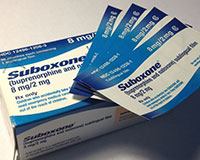The half life of a drug is how long the drug stays in your system. Many drugs are described in half life because it determines when you take the next dose of the drug. This is particularly important with both addictive drugs and drugs that combat addiction. The half life determines when you will experience withdrawal symptoms in either case. In the case of opiates, the half life determines when you will go into withdrawal from the opiates. In the case of Suboxone, the half life determines when you will go into opiate withdrawal.
What is Suboxone?

Suboxone is a form of treatment for opiate addiction.
Suboxone is a popular replacement drug for opiate addiction. It is made from two separate addiction drugs, Buprenorphine and Naloxone.
- Buprenorphine is a opiate agonist. This means that it binds to the opioid receptors in the brain and stops the opiate from binding there. It also stops the withdrawal process. This counteracts cravings and other negative effects of opiate withdrawal. Buprenorphine when used by itself, is mildly addictive and has some pain relieving properties. People often compare it to methadone because of its similar properties and actions.
- Naloxone is an opiate antagonist. This means when you take it, it completely reverses the effects of an opiate and sends the body into immediate withdrawal. The popular antioverdose drug Narcan is made from Naloxone. In Suboxone, it acts to block any addictive effects of the buprenorphine.
You cannot overdose on Suboxone. Your body processes Suboxone too quickly to overdose on the drug. The effects that you get from Suboxone plateau after a certain amount depending on your body chemistry.
Why take Suboxone?
Most people take Suboxone to avoid opiate withdrawal. They want to stop using opiates and do not want to suffer the adverse effects of detoxing from it. For those who are at a high risk of using an opiate while on Suboxone, it prevents them from getting high off the opiate. People take Suboxone because:
- they are addicted to opiates,
- they are not a candidate for methadone,
- they do not wish to become addicted to methadone,
- they are worried about overdose,
- they have some form of chronic pain, and
- they have relapsed using other treatments.
There are many reasons to use Suboxone to stop an opiate addiction; each person has his or her reasons for choosing it.
How is Suboxone Prescribed?
Doctors prescribe Suboxone as a sublingual film or a pill. The sublingual film is placed under the tongue or in the check until it is dissolved. Your doctor sets the dosage. If you have a strong addiction, doctors prescribe more of the Suboxone. If it is only a mild addiction, doctors prescribe less of the drug. When you first start on Suboxone, a doctor monitors your withdrawal symptoms and adjusts your dose accordingly. There are a wide variety of Suboxone dosages available and if the doctor finds it necessary the dose can be carefully adjusted to fit your withdrawal symptoms.
What are the Side Effects of Taking Suboxone?
According to the Food and Drug Administration, Suboxone’s side effects are:
- runny nose,
- nausea,
- vomiting,
- flu- like symptoms,
- sweating,
- insomnia,
- mood swings, and
- general stomach upset.
These effects are not enough to bother most people enough to stop taking Suboxone. Suboxone is slightly addictive but not nearly as addictive as some of the alternatives for opiate withdrawal.
Why Worry about the Half Life of Suboxone?
The half life of Suboxone is how long it stays in your system. Many people worry about the half life because when it leaves your system, you wind up in withdrawal if you did not taper your dose down. By using the half life doctors can time your next dose. Most people who take Suboxone know exactly when to take their next dose to avoid any unpleasant symptoms.
If you are following a tapering schedule, knowing the half life also helps you to taper down correctly. Drugs with a long half life stay in the system longer, drugs with a shorter half life clear the system faster. Doctors use the Suboxone half life to prevent overdose, keep up a taper schedule, and figure out exact dosing regiments.
The Half Life of Suboxone
According to Reckitt Benckiser Healthcare, Suboxone is addictive but less so than most other opioid medications. It carries a half life of between 20 to 70 hours. This means it stays in the body for between one day and three days. The length of time that it stays depends on several factors. These factors are:
- body weight,
- length of time you have taken Suboxone for,
- how long you took opiates for,
- metabolism,
- other drugs you are taking,
- other medical conditions, and
- what your dose of Suboxone is.
Depending on how much Suboxone you are taking the maximum amount of time that it will be in your system is around 72 hours, unless you are on a very heavy dose. It is extremely important to remember that Suboxone is addictive. If you take more than the recommended dose it will not make you feel any better than if you stuck to the dosing schedule.
Only doctors certified in addiction medicine can prescribe Suboxone. Addiction to opiates is a difficult thing to stop. If you need help, call us at 888-646-0865 (Who Answers?) . You do not have to be a slave to your addiction any longer.